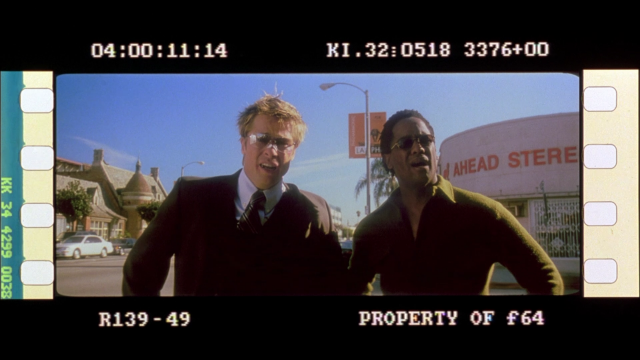By 2002, Steven Soderbergh was pretty much given a blank check to make whatever the hell he wanted, after the massive success of his last three films. It’s a testament to how much Soderbergh desires to experiment that he took “whatever the hell you want” as a challenge to make the least commercial project possible, a tale of relationship drama, autoerotic asphyxiation, and misguided plays about Hitler’s sex life that’s shot on anti-glorious early DV and beholden to Dogme 95-esque rules during shooting (no trailers or craft services, only practical locations, using the actors’ make-up, hair, and wardrobe). Critics felt it was a prolonged exercise in mental masturbation, audiences stayed away, and the film has since become something of a shameful footnote in Soderbergh’s career, with all but a few supporters coming out of the woodwork. I guess it should go without saying that I’m one of those supporters, but I should mention it anyway.
The meat of Full Frontal takes place in the warm-up to a birthday party for an elite Hollywood producer (David Duchovny), with frequent branching off into his and writer Carl Bright (David Hyde Pierce)’s latest film, Rendezvous, about a reporter (Julia Roberts) interviewing and falling in love with an actor (Blair Underwood) who’s making a dumb action movie with Brad Pitt. Meanwhile, the actor playing the actor is sleeping with Carl’s wife Lee (Catherine Keener), who’s taken to making bizarre demands of her employees, while her sister Linda (Mary McCormack) is angling to meet the person she’s been dating online, who turns out to be a playwright (Enrico Colantoni) whose play about Hitler is running into problems due to its temperamental lead (Nicky Katt). All of this real-life personal drama is shot on DV, while Rendezvous is shot on 35mm, with what Soderbergh calls in the commentary “really good TV lighting”. Don’t worry, there won’t be a test on all this.
If the synopsis makes Full Frontal seem like some impenetrable experiment (as does its absurd 4.8 score on IMDb), its pleasures are more accessible than they may seem. A lot of it is genuinely funny, and not in some obscure, dry way. Pierce gets to indulge in some primo comedy-of-mortification as he’s repeatedly humiliated at work (once in a failed attempt to do the porn name game with a coworker) and eventually fired (by none other than Soderbergh’s producer on Ocean’s Eleven, Jerry Weintraub), a cameo by a certain figure in a familiar setting in Rendezvous is delightful for any Soderbergh fan watching, and its barrage of small parts and cameos (including one hilariously reluctant one by the director himself) are a hoot, especially Pitt, who needs David Fincher’s assistance to figure out exactly what his role is in Rendezvous. But the best part of the movie is undoubtedly Katt’s sections, thanks to the utter absurdity of the play he’s performing and his willingness to play to every director’s nightmare about actors (his explanation for what he did to drive the actress playing Eva Braun away, which will go unspoiled here, is one of the funniest things in all of Soderbergh’s canon), making this, if nothing else, essential viewing for Katt devotees (looking into your soul right now, Miller). Given the film’s immediate pleasures, the culprit for its piss-poor reception likely is the use of ugly, primitive DV, which, admittedly, mostly just looks pretty bad (not bad enough to distract from the film’s many joys, but that’s not an opinion shared by most), but Soderbergh being who he is, he manages to play with it in a few sequences in a way that makes it look beautiful in its own twisted way, especially a hotel room tryst viewed in abstract blurs through a vent. It may not be one of Soderbergh’s best, but it certainly does not deserve the neglect it’s been subject to, and you’re bound to find plenty to like in it (don’t use this as a guarantee in the event that you hate it and hate me for recommending it).
Full Frontal is available on Netflix Instant.

